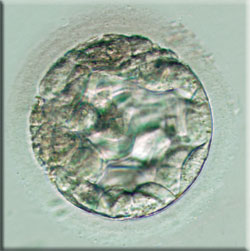Now that we've offered a summary of this article--which also serves as a recap for much of this blog--we are interested in engaging with it more fully, and examining it more critically.
This article skillfully outlines nearly all of topics important to the current debates over cloning technologies, and raises the crucial ethical questions that society and science alike must grapple with as cloning technology advances. It recognizes that we cannot separate these ethical questions and debates from cloning, or try to analyze cloning without taking them into consideration. Try as we might, it is nearly impossible to discuss the role and future of cloning in society and science, without thinking about the ethics involved: do we have the right to manufacture life, or "manipulate some human beings for the benefit of others?" Does the potential good that may be derived from therapeutic cloning techniques outweigh moral and ethical qualms? Questions such as these must always remain in the back of our heads as we take on the challenge of exploring the biotechnology of cloning in medicine.
One thing that this article failed to mention, is the notion of cloning genes and genes alone, rather than cloning for reproductive purposes or cloning human embryos for scientific purposes. Although the article distinguishes between "cloning-to-produce-children" and "cloning-for-biomedical-research" it does not make any further differentiations in the types of cloning that may be used "for biomedical research." Yes, of course, one such type of cloning is the cloning of human embryos, so that cloned stem cells may be harvested and manipulated for therapeutic uses in a patient (this is the only type of cloning-for-biomedical-research that the Council considers in this article). But there is another type of cloning, also for research and medical purposes, that is ignored. Scientists are able to clone specific genes, introduce them to a vector of some sort (a plasmid, for instance), and then insert the recombined DNA into an organism; as the inserted cells divide, the target gene will be perpetuated in the organism (see the blog posting on gene-altered goats as an example of this cloning technology). Why does the article neglect this type of cloning? Is it simply that this method is seen as less ethically problematic? Does this method border on gene therapy and DNA recombination, and fall outside the realm of what is considered 'true' cloning?
We find it problematic that the Council does not recognize this type of cloning. Perhaps, even if they did not deem it worthy of greater consideration or evaluation, they might have explained their reason for its exclusion. For instance, they decided not to examine it deeply because they believe it is less of an ethical dilemma, or they think that it is already widely accepted as a safe scientific procedure.
Additionally, in our research we found a number of recent articles on the cloning of other animals. Although the article defines the notion of animal cloning, it is no more than a passing mention of this technology. We wondered why they dismissed this form of technology so easily. True, it is not exceedingly relevant to the issues that the Council focuses on, but we think it is an important omission to acknowledge. As later articles in our blog demonstrate, companies have started saying that they will clone your pets--if this becomes a common practice, our society will slowly become accustomed to the idea of animal cloning (even if the idea is still revolutionary today). What if we become de-sensitized to animal cloning? Then, suddenly, human cloning is not such a big leap to make. We think that the article may have benefitted from delving into the issue of animal cloning a bit more.
The Council does as it promises to do, and provides sound discussions and opinions on the many ethical considerations relevant to cloning technologies. It presents both sides of each debate, even when the Council members were in consensus: for instance, the Council agrees in its position against cloning-to-produce-children, but it still lists the common arguments in favor of this type of cloning. Let us turn to the discussion on the ethics of cloning-for-biomedical-research:
Clearly, both sides of the debate have strong foundational arguments. We think that most people would agree that trying to alleviate human suffering is a noble cause, and one that is generally supported. But we also ideally want to respect all human life, no matter how young. The difference between being for or against biomedical cloning can often come down to a simple time line: at what point in development do we consider an embryo to be morally equivalent to any other human? This is a matter of personal opinion, which is why the cloning debates can be so heated. Some people believe that as soon as an egg is fertilized, it is a potential human, and deserves to be treated as any other human. Others say that an embryo has only "intermediate moral status" until it is a month old... It will always be difficult, perhaps even impossible, to come to any sort of agreement on this. We must consider what this means for cloning--if the people cannot agree, does it fall to the government to decide for us?
The Council, of course, writes this article for the purpose of recommending some course of action for the government to take with regard to public policy. What should we do about cloning? Is regulation necessary? Should cloning be banned altogether? The very fact that this is the purpose of the Council demonstrates how far we are from considering cloning in terms of healthcare. We have not even decided whether cloning should be legal. We recognize that many of the articles considered in this blog do not address cloning's position in the healthcare debates, but this is because cloning is too new of a technology, too underdeveloped and imperfect, to be considered as a viable treatment or therapy just yet. Until we understand cloning, and all its implications more fully, and until we have perfected techniques of cloning and conducted further experimentation and research, we cannot be sure that cloning will actually prove to be as useful as we currently hope.
Many researchers and scientists claim that cloning holds great promise: that some cloning techniques may help to develop treatments for diseases such as Parkinson's, or may lead to a huge leap forward in regenerative medicine. But for now, we do not know. We do not know if we will ever succeed in these ventures, or if we will ever be able to clone safely enough. There are many hurdles to overcome before cloning will be considered in the formal healthcare debates.
For now, we, the people of America, must engage in these debates on cloning technologies. We must decide whether we believe that cloning is ethically wrong, or whether we think potential benefits outweigh known costs. We must show our support of cloning, or we must petition for a ban on this technology. But first, we have to make sure that we have all the facts straight.






 This seems to be a matter of controversy over definitions. Is a clone really the same thing as an identical twin? Do we not have to take into consideration the matter of shortened telomeres, and the fact that clones are generally created from much older cells? We still do not fully understand how adult cells are reprogrammed to become stem cells again, and as long as we don't have this knowledge can we really equate a clone with a twin?
This seems to be a matter of controversy over definitions. Is a clone really the same thing as an identical twin? Do we not have to take into consideration the matter of shortened telomeres, and the fact that clones are generally created from much older cells? We still do not fully understand how adult cells are reprogrammed to become stem cells again, and as long as we don't have this knowledge can we really equate a clone with a twin? The article cautions its readers not to get their hopes up quite yet. Although the experimental procedure shows promise, the article warns that "only two groups, one in Britain and one in the US, have succeeded in cloning human embryos, and none has yet produced stem cells from a cloned embryo." So how, realistic, really, is it to believe that this therapy will soon be used in humans? The article also notes that cloning is hugely inefficient; scientists are still not able to consistently produce a viable line of cloned embryonic stem cells. On the contrary, "cloning... [usually] requires hundreds of eggs to produce a single viable clone, [which] is also expected to limit therapeutic applications."
The article cautions its readers not to get their hopes up quite yet. Although the experimental procedure shows promise, the article warns that "only two groups, one in Britain and one in the US, have succeeded in cloning human embryos, and none has yet produced stem cells from a cloned embryo." So how, realistic, really, is it to believe that this therapy will soon be used in humans? The article also notes that cloning is hugely inefficient; scientists are still not able to consistently produce a viable line of cloned embryonic stem cells. On the contrary, "cloning... [usually] requires hundreds of eggs to produce a single viable clone, [which] is also expected to limit therapeutic applications."










 News reached the public for the first time that such a feat was possible... and immediately, debates over the ethics of cloning and the potential for human cloning arose. But even then, Ian Wilmut, one of the leading scientists in the team from Roslin Institute in Edinburgh that succeeded in creating the cloned sheep Dolly, told the press that: ''What this will mostly be used for is to produce more health care products.... It will enable us to study genetic diseases for which there is presently no cure and track down the mechanisms that are involved. The next step is to use the cells in culture in the lab and target genetic changes into that culture.''
News reached the public for the first time that such a feat was possible... and immediately, debates over the ethics of cloning and the potential for human cloning arose. But even then, Ian Wilmut, one of the leading scientists in the team from Roslin Institute in Edinburgh that succeeded in creating the cloned sheep Dolly, told the press that: ''What this will mostly be used for is to produce more health care products.... It will enable us to study genetic diseases for which there is presently no cure and track down the mechanisms that are involved. The next step is to use the cells in culture in the lab and target genetic changes into that culture.''



